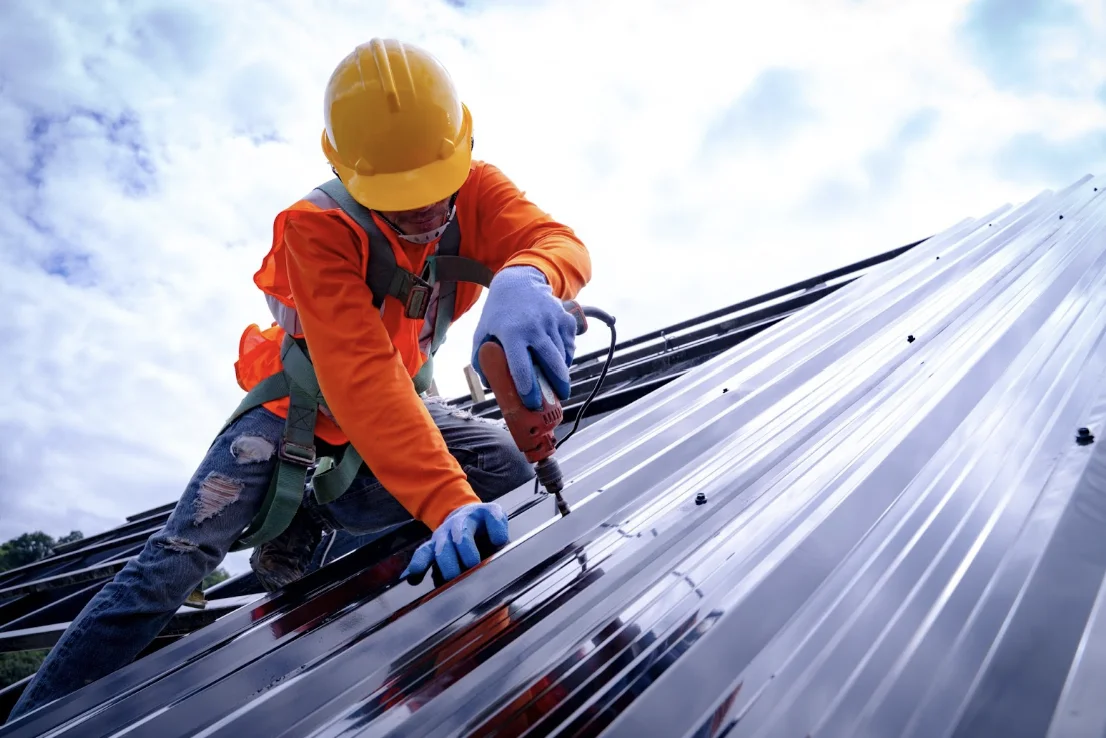When choosing a roof, either for a new house or replacing an old one, there are several options. Metal roofs are one of these options, with some unique benefits and drawbacks.
This article will explore metal roofs, the types available, and their pros and cons.
Types and Styles of Metal Roofs
Metal roofs are constructed from materials like steel, aluminum, copper, zinc, and tin. These metals are crafted into different styles including vertical seam panels, pre-formed panels, and granular coated panels. Additionally, they come in various appearances such as shingles, slate, tile, shakes, or vertical panels. It’s essential for metal roofing to undergo testing and receive approval to ensure it meets high standards for wind and fire resistance, among other safety measures.
Advantages of Metal Roofs
-
Longevity
Metal roofs are known for their long life. They can last 40 to 70 years, much longer than traditional roofs like asphalt, which typically last 12 to 20 years.
-
Durability
Metal roofs are very strong. They can handle wind speeds up to 140 miles per hour and don’t easily crack or corrode. They are also resistant to impacts, but this depends on the type of metal roof you choose. Metal roofs also don’t need many repairs, but it’s a good idea to check them once in a while to ensure they are in good shape.
-
Safety
Metal roofs are safe because they don’t catch fire easily. This is a big plus during wildfires or lightning storms.
-
Energy Efficiency
Metal roofs help save money on energy bills because they reflect sunlight. This keeps the house cooler and can reduce air conditioning costs by 10-25%.
-
Environmental Impact
Metal roofs are also good for the environment. They are mostly made from recycled materials and can be completely recycled when they’re no longer needed. This is better than traditional roofing waste, which greatly adds to landfills.
Disadvantages of Metal Roofs
-
Cost
A significant disadvantage of metal roofs is their price, which can be two to three times higher than other roofing materials. However, the longevity of metal roofs may justify the initial investment if you intend to stay in your home for a prolonged period.
-
Noise
Metal roofs are known to be noisy during intense rain or hailstorms. This noise can be mitigated by installing additional insulation in the attic, though it may increase the overall cost.
-
Mechanical Issues
Metal roofs expand and contract with temperature changes. This can cause issues with the fasteners used to hold the roof panels in place, which may need to be replaced over time. Also, the screws and washers used might wear out depending on the weather.
-
Aesthetic Concerns
If you need to repair or add to a metal roof later, it can be hard to find an exact color match. This might be a problem if you are particular about the appearance of your home.
-
Performance Risks
If not installed properly, water might collect on the roof, leading to damage over time. Also, cheaper metal roofs might be thinner and less durable and could rust or dent easily.
Conclusion
Metal roofs offer many benefits, such as long life, durability, safety, energy efficiency, and environmental friendliness. However, they are expensive, can be noisy, and have some performance risks. Before deciding on a metal roof, consider these factors and whether it suits your needs and budget. A metal roof might be a good investment despite its higher upfront cost if you plan to stay in your home for a long time.
FAQs
What is the installation process for metal roofs?
The installation process for metal roofs involves several steps including removing the old roof (if necessary), preparing the roof deck, installing an underlayment, and then laying down and securing the metal panels or shingles. The specific process can vary depending on the type of metal roof and the existing structure.
Can metal roofs be installed over existing shingles?
Yes, metal roofs can sometimes be installed over existing shingles, provided the roof structure can support the additional weight and there are no local building code restrictions. This can save on the cost and inconvenience of removing old roofing materials, but it’s important to consult with a professional to ensure it’s suitable for your specific situation.
Can metal roofs be recycled at the end of their life?
Yes, metal roofs are 100% recyclable at the end of their life. This makes them an environmentally friendly option as they contribute to reducing waste in landfills and can be continuously recycled without loss of quality.
How do metal roofs affect a home’s resale value?
Metal roofs can increase a home’s resale value due to their durability, longevity, and energy efficiency. Homes with metal roofs often attract buyers who are looking for low-maintenance and energy-efficient options, which can make them more appealing in the housing market.
Get the right coverage for your home with tutenagency
New tutenagency customers?
Quote homeowners insurance online or call (334) 502-5111 to insure your home.
Legal Disclaimer: ADVERTISING MATERIAL ONLY. Do not rely on this site or this article for legal or financial advice. The information provided on 210agency.com is strictly for educational purposes and to provide you with general educational information. Since state laws and financial regulations are subject to change, please schedule an appointment with an attorney or qualified financial advisor in your area to further discuss your personal situation. This public information is neither intended to, nor will it, create an attorney-client or financial representative relationship.

